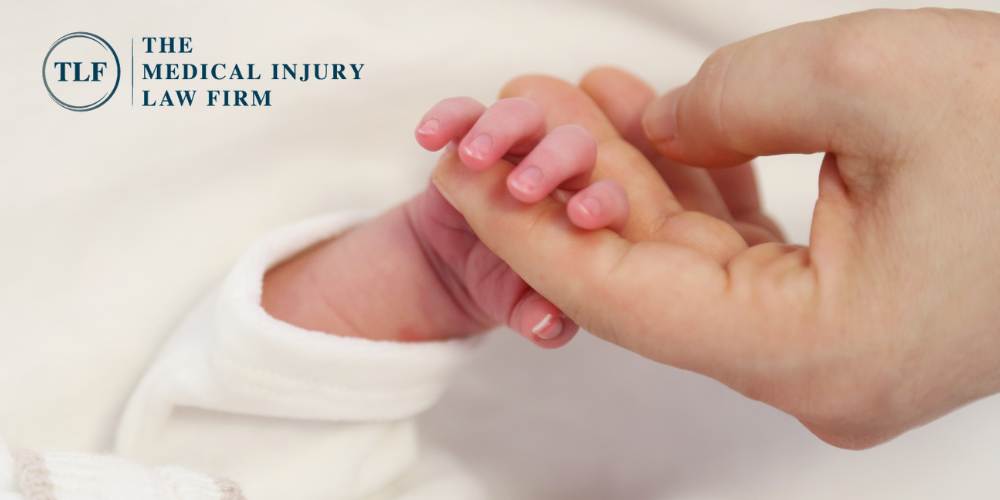Putting Our Knowledge And Experience To Work
Home » Birth Injuries » Birth Asphyxia Attorney
Birth Asphyxia Attorney
Experienced Ohio and Northern Kentucky Birth Injury Lawyers for Birth Asphyxia Cases
The birth of a child is a momentous occasion in every family’s life. Parents spend months planning for their newborn, with shopping trips, baby showers, and more. During pregnancy, parents plan as their lives are about to change with the arrival of their child. However, one thing that many parents don’t plan for is negligent actions by the medical professionals they trust. One birth injury that can result from medical negligence is birth asphyxia. At TLF: The Medical Injury Law Firm, our Northern Kentucky and Cincinnati medical malpractice attorneys are deeply committed to representing parents impacted by birth injuries like asphyxia.
Medical malpractice claims can be especially difficult considering the powerful legal teams representing hospitals and doctors. However, our medical malpractice law firm knows the challenges that come with these sensitive cases and will not back down. At TLF, we are dedicated to providing compassionate yet aggressive representation to ensure your family receives the justice and compensation you deserve.

If your child was injured during labor and delivery, you could have a medical malpractice claim. To learn more about your legal options, call TLF: The Medical Injury Law Firm toll-free at (800) 698-4054 to schedule a free consultation with an Ohio or Northern Kentucky birth injury lawyer on our team today.
What is Birth Asphyxia?
Birth asphyxia, also referred to as perinatal asphyxia, is a severe medical condition that occurs when a newborn is deprived of oxygen before, during, or immediately after birth. This lack of oxygen can lead to significant health complications, affecting a baby’s brain, heart, lungs, and other vital organs.
The severity of the condition can range from mild to severe, with potential long-term consequences such as developmental delays, cerebral palsy, or even life-threatening outcomes. The causes of birth asphyxia can also vary, including complications with the umbilical cord, placenta, or maternal health problems.
At TLF: The Medical Injury Law Firm, our birth asphyxia attorneys are ready to represent you in the event of injuries caused by medical malpractice. To discuss your child’s injuries with one of our compassionate attorneys, contact an Ohio or Kentucky birth injury lawyer on our team today.
Types of Asphyxia
Asphyxia can manifest in various forms, each stemming from different causes and presenting unique challenges in both diagnosis and treatment. These types range from physical obstructions that impede breathing to environmental factors that reduce oxygen levels in the air.
Antepartum Asphyxia
Antepartum asphyxia refers to the condition where a fetus experiences a lack of oxygen before the onset of labor. This type of asphyxia can result from various complications during pregnancy, such as issues with the placenta, like placental insufficiency, umbilical cord problems, or maternal health conditions that affect blood flow and oxygen delivery to the fetus.
The consequences of antepartum asphyxia can be significant, potentially leading to developmental delays, neurological disorders, or stillbirth if not promptly identified and managed. This emphasizes the importance of comprehensive prenatal care, including regular monitoring of fetal heart rate and movements, to detect and mitigate risks of oxygen deprivation before labor begins.
Intrapartum Asphyxia
Intrapartum asphyxia occurs during the labor and delivery process when the baby experiences a significant decrease in oxygen supply. This critical condition can be triggered by various factors such as prolonged labor, administration of uterine stimulants to induce or augment labor, such as Pitocin or Cytotec, compression of the umbilical cord, or complications related to the placenta or uterus.
The risks associated with intrapartum asphyxia include permanent brain damage, leading to conditions like cerebral palsy, as well as other potential lifelong disabilities. Early recognition and intervention by a medical professional to expedite delivery and remove the baby from the oxygen-starved uterine environment is essential to manage this emergency situation, aiming to restore oxygen supply to the baby as quickly as possible to minimize any adverse outcomes.

Postpartum Asphyxia
Postpartum asphyxia refers to the condition where a newborn experiences a lack of oxygen after birth and during the initial stages of life outside the womb. This critical period can present many challenges, including difficulty initiating or maintaining breathing, leading to oxygen deprivation.
Factors contributing to postpartum asphyxia may include respiratory distress syndrome, infections, or congenital abnormalities affecting the baby’s airways or cardiovascular system. The quick identification and treatment of postpartum asphyxia are vital to prevent potential long-term effects on the child’s neurological and physical development. Failure to properly manage these conditions in the postnatal period can worsen or limit the chance of a better outcome from these conditions.
Acute Birth Asphyxia
Acute birth asphyxia is a sudden and severe lack of oxygen to the newborn during the birth process, often resulting in immediate distress and requiring urgent medical intervention. This condition can arise from complications such as umbilical cord prolapse, placental abruption, or maternal hypotension, all of which drastically reduce the oxygen supply to the baby.
The impact of acute birth asphyxia can be profound, with the potential for significant neurological damage, including brain injury and other critical conditions that may have lasting effects on the child’s health and development.
Chronic Birth Asphyxia
Chronic birth asphyxia, unlike its acute counterpart, unfolds over a prolonged period, typically developing during the later stages of pregnancy. This condition results from a sustained or recurrent reduction in oxygen supply to the fetus, often due to chronic placental insufficiency, maternal health issues, or problems with the umbilical cord.
The gradual nature of chronic birth asphyxia means it can subtly affect the fetus’s growth and development, possibly leading to intrauterine growth restriction (IUGR) and increasing the risk of long-term developmental and cognitive challenges.

Birth Asphyxia Symptoms
The symptoms of birth asphyxia can vary widely depending on the severity and duration of the oxygen deprivation. Immediately after birth, affected newborns may exhibit weak or absent breathing efforts, poor muscle tone, reduced heart rate, and a bluish or pale skin coloration indicative of low oxygen levels.
Additional symptoms may include a weak cry or no cry at all, lethargy, and a low Apgar score, which is a quick test performed on a baby between 1 and 5 minutes after birth to assess the newborn’s heart rate, breathing, muscle tone, reflex response, and color. In severe cases, babies may experience infant seizures or fall into a coma. Umbilical cord blood gasses are often collected after the baby is delivered to test for metabolic acidosis, or acid in the blood, a systemic consequence of oxygen deprivation.
Birth Asphyxia Long-Term Effects
The long-term effects of birth asphyxia can be profound and life-altering, significantly influencing a child’s developmental trajectory and overall quality of life. Depending on the severity and span of oxygen deprivation, children may experience a range of neurological and developmental disorders, including cerebral palsy, which affects muscle tone and movement, and intellectual disabilities, which can impact learning and cognitive function. Other potential long-term effects include seizure disorders and sensory impairments.
What Causes Birth Asphyxia?
Birth asphyxia can result from several factors that interfere with the oxygen supply to a baby before, during, or immediately after birth. Some of the most common causes include:
- Complications with the Umbilical Cord: Problems such as a prolapsed or compressed umbilical cord can significantly lower or cut off the baby’s oxygen supply.
- Placental Complications: Conditions like placental abruption (where the placenta detaches from the womb’s wall prematurely) or placenta previa (where the placenta covers the cervix) can disrupt oxygen flow to the fetus.
- Inadequate Oxygen in the Mother’s Blood: Maternal conditions such as respiratory issues, anemia, or cardiovascular problems can decrease the oxygen available to the baby.
- Difficult or Prolonged Labor: Extended labor can lead to fetal distress, reducing oxygen supply and potentially causing asphyxia.
- Preexisting Fetal Conditions: Certain fetal conditions can make a baby more susceptible to asphyxia, such as infections or congenital heart problems.
- Maternal Health Issues: Conditions like hypertension, diabetes, low blood pressure, or preeclampsia in the mother can affect blood flow and oxygen delivery to the fetus.
- Delivery Complications: Situations during delivery, such as emergency C-sections or the use of delivery instruments like forceps or vacuum extraction tools, can also contribute to birth asphyxia.
Understanding these causes is crucial for healthcare providers to prevent, recognize, and treat birth asphyxia effectively. If the mother has pre-existing medical conditions, it’s up to the doctor and medical staff to be aware and take proper precautions to diagnose potential pregnancy complications and help the mother through the birthing process.

What Happens When Medical Negligence Causes Birth Asphyxia?
When medical negligence leads to birth asphyxia, it can have profound implications on the newborn’s health and the family’s emotional well-being. In such cases, it’s essential to establish that a doctor-patient relationship existed, forming the basis of any birth injury claims.
This relationship is critical as it confirms the healthcare provider’s duty to deliver a standard of care to the patient. If this duty of care is breached due to negligent actions or omissions by medical professionals during prenatal care, labor, or delivery—such as failing to monitor fetal distress, improper use of delivery tools, or not addressing complications timely—it can directly contribute to birth asphyxia.
The consequences of such negligence can be severe, potentially leading to long-term disabilities for the child. Families affected by birth asphyxia caused by medical negligence may seek legal action to address the harm done.
What To Do If Your Child Suffers Asphyxia-Related Birth Injuries
If your child suffers from asphyxia-related birth injuries, it’s crucial to take immediate and informed actions to protect your child’s health and legal rights. First and foremost, it’s important that you ensure your child receives the necessary medical care and support he or she needs, including any recommended treatments or therapies to address the injury’s immediate and long-term effects. Be sure to document all medical records, treatments, and communications with healthcare providers, as these documents are vital for understanding the full scope of the injury and its implications.
Consulting with an experienced birth asphyxia lawyer from TLF: The Medical Injury Law Firm can be a critical next step. Our legal professionals specialize in navigating the complexities of birth injury claims, helping families understand their rights and potential legal options. An attorney can assess the events surrounding the birth injury, determine if negligence by a medical professional contributed to the asphyxia, and guide you through the process of seeking compensation for medical expenses, ongoing care, and other damages.
How the Ohio and Kentucky Medical Malpractice Attorneys at TLF Can Help
The Ohio and Kentucky medical malpractice attorneys at TLF are dedicated to assisting families affected by medical negligence, including cases of asphyxia-related birth injuries. With a deep understanding of state-specific legal landscapes, complex medical issues and the challenges of medical malpractice claims, our team is well-equipped to navigate the often challenging journey toward justice and compensation.
By carefully reviewing the mother and baby’s medical records, consulting with our medical experts, and leveraging our extensive legal experience, we work to build a strong case highlighting the specific instances of negligence and the impact that negligence has on your child’s life.

Call TLF: The Medical Injury Law Firm To Arrange a Free Initial Consultation Today
At TLF: The Medical Injury Law Firm, our attorneys are committed to advocating for your family’s rights, offering compassionate legal support while aggressively pursuing compensation that is appropriate to the suffering that medical negligence has caused for you and your family. We understand the deep emotional and financial toll these situations can impose on families, and we’re here to guide you through every step of the legal process, ensuring your voice is heard and your child’s future is protected.
To schedule a free consultation with an Ohio or Northern Kentucky birth asphyxia attorney at TLF, call our toll-free number (800) 698-4054 today. You can also reach our Cincinnati office at (513) 651-4130, our Covington office at (859) 578-9130, or contact us online.
Practice Areas
You Pay No Fees Unless We Win!
We are happy to offer a free consultation to evaluate your case. If you hire us as your legal counsel, we will represent you on a contingency-fee basis. You will pay no attorneys’ fees unless we recover financial damages.
